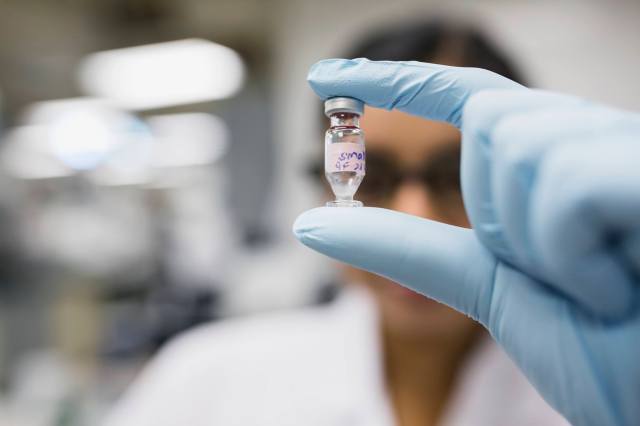Credit: Getty

How many discoveries made since 1990 have been honoured with a Nobel Prize in Physics? The answer, according to Patrick Collison and Michael Nielsen in a fascinating essay for the Atlantic, is just three.
To be clear, the prize has been awarded in every year since 1990, but mostly in recognition of earlier discoveries.
Furthermore, the average age of a new laureate has increased across the history of the physics prize. There’s a fairly distribution around the mean, but, these days, a physicist is more likely to win at the end of a career than halfway through it.
One explanation is that Nobel committees are taking a wait-and-see approach to assessing the significance of particular achievements. Another, more disturbing, explanation is that the pace of scientific progress is slowing down – and that the unambiguous breakthroughs demanding immediate recognition are now few and far between.
Is there a rigorous means of settling the question?
Collison and Nielsen concede that it’s “surprisingly difficult to measure scientific progress in meaningful ways”. Nevertheless, they’ve had a go – with an ingenious method that almost deserves a Nobel Prize of its own.
What they did was to randomly pair different prize-winning discoveries and then ask leading scientists to say which of the two was the more significant:
“Think of the survey as a round-robin tournament, competitively matching discoveries against each other, with expert scientists judging which is better.
“For the physics prize, we surveyed 93 physicists from the world’s top academic physics departments… and they judged 1,370 pairs of discoveries.”
According a score calculated on the basis of the replies, the golden era of physics was between the wars. No surprise there – the authors quote Paul Dirac as saying it was a time when “even second-rate physicists could make first-rate discoveries”. There was another purple patch in the 1960s – but since then a decline seems to have set in.
The same exercise was repeated for chemistry and physiology/medicine, where there was much less evidence of a recent decline. However, there’s no evidence of accelerating progress either, which, given the massive surge in the resources devoted to science over the last half-century, is what might have been expected. The authors show that since 1960s there’s been a big increase in the number science and engineering PhDs awarded in America and in the number of scientific publications and in the level of public funding for science.
Therefore outputs have not kept pace with inputs. So even if we can’t say that science is slowing down, it does have a productivity problem.
This maybe because we’ve discovered all the stuff that was comparatively easy to discover. There was a time when all one needed for a breakthrough was a spare genius or two and some half-way decent scientific instruments, but no longer:
“When Ernest Rutherford discovered the nucleus of the atom in 1911, he published it in a paper with just a single author: himself. By contrast, the two 2012 papers announcing the discovery of the Higgs particle had roughly a thousand authors each. On average, research teams nearly quadrupled in size over the 20th century, and that increase continues today.”
In the 17th, 18th and 19th centuries a remarkable number of scientists and inventors were also clergymen. It’s a history that often crops up in discussions about the relationship between science and religion, but it’s also illustrative of the accessibility of the scientific and technological frontier. In the 21st century, the age in which important discoveries could be regularly made by talented amateurs is sadly long past. The frontiers of knowledge are now further away from normal human experience – and require a much greater input of resources to reach, let alone extend.
However, Collison and Nielsen, do raise a more hopeful possibility – which is that these difficulties may be due to us pushing too far in some directions, while neglecting to explore others:
“If we see a slowing today, it is because science has remained too focused on established fields, where it’s becoming ever harder to make progress. We hope the future will see a more rapid proliferation of new fields, giving rise to major new questions. This is an opportunity for science to accelerate.”
Perhaps we need to give at least some of our scientists greater freedom to pursue unexplored avenues. Though there’s been a big increase in public and private funding for research over recent decades, the money filters down through various bureaucratic structures – and bureaucrats have a bias to well-trodden paths (as do impatient investors).
So, in this era of super-colliders and space-based telescopes, let’s embark another grand experiment. Let’s shift, say, 5% of science funding to institutions where scientists are maximally unencumbered by the research bureaucracy, or by academic fashion, or by artificial distinctions between different disciplines and specialisms, or by the need to publish for the sake of it, or by the requirement to take on students they have no desire to teach. Call it the University of Pure Curiosity and see what happens.
There’s no guarantee it would produce the desired results – but then, in science, there never is.










Join the discussion
Join like minded readers that support our journalism by becoming a paid subscriber
To join the discussion in the comments, become a paid subscriber.
Join like minded readers that support our journalism, read unlimited articles and enjoy other subscriber-only benefits.
Subscribe